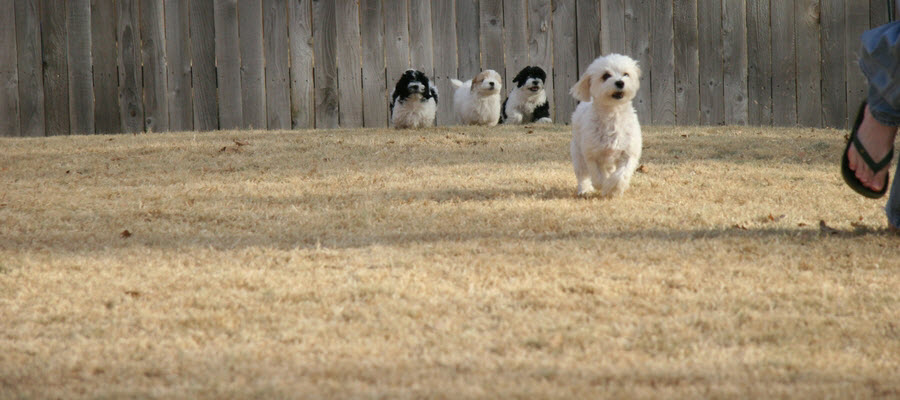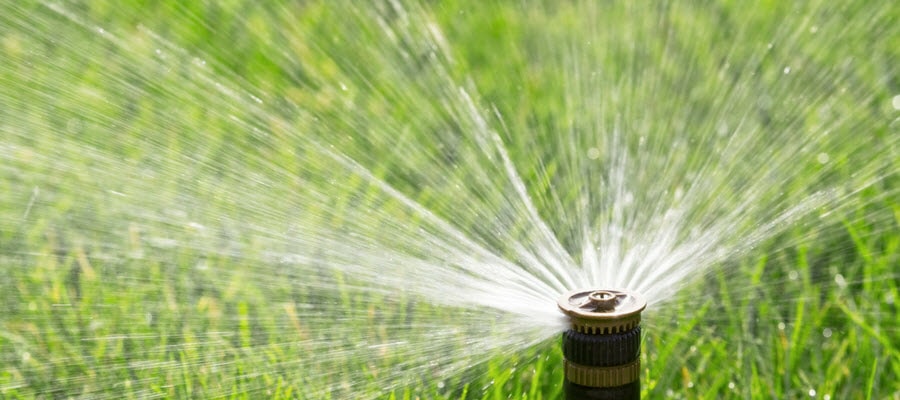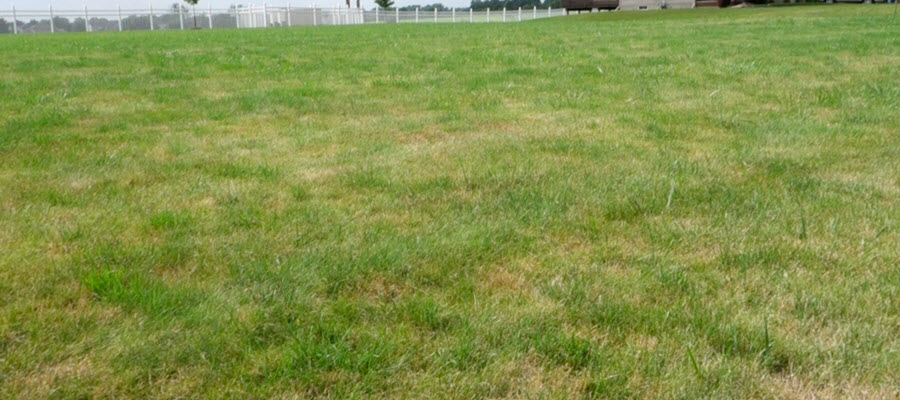Summer Lawn Tips (Cool Season Lawns)
- "The Lawn Care Nut"July 13, 2017
Summer time in the cool season lawn: it’s the smell of barbecue smoke, the sound of an impact sprinkler and the feeling of soft green grass under bare feet. Your hard work all spring has paid off and you’ve got the greenest, thickest lawn on the block, savoring every minute as you watch your family and friends enjoy time on your little green patch of suburban land. But this is no time to reminisce, you must stay vigilant and make some tough decisions!
I think it goes without saying that we all applied a full dose of Milorganite this July 4. The purists among you applied that day because it’s tradition, others of you possibly the weekend before, or a few days after. And now you’re wondering, “what’s next?”
Going Dormant
Summer is a trying time for lawns, especially cool season lawns like Kentucky Bluegrass, Rye and Fescue. That’s because these turf types love the more mild seasons of spring and fall and tend to go dormant in the extremes of winter and summer. That is where you need to make a decision:
1) Do you want to keep it green and vigorous?
2) Do you want to let it naturally go into summer dormancy?

Just so you know, letting your cool season turf go dormant in summer is not a bad thing, and in fact, it’s quite natural. It’s your turf’s way of basically saying to you “Wow, these are some extreme heat and dry spells we are getting here, maybe we will just take a nap until things get more chill in September.”
As long as your lawn is getting at minimum ½” of irrigation or rain per month, the grass crowns will stay alive until fall brings in more rain and cooler temps. The downside here is your lawn will be brown all summer and you’ll have to keep the foot traffic to a minimum. That’s because dormant grass (in summer or winter) also has no resilience (or very little) to any kind of physical or mechanical stress. The crunchy feeling you get under foot in a dormant lawn should be a clue that you are literally “cracking” the grass plant. Too much physical stress and the grass crowns will break killing the entire plant.
The other challenge you’ll have is the fact that summer turf damaging pests like sod-webworm or dollar spot disease also turn lawns brown - giving you the hint that trouble is afoot. But when your entire lawn is crispy dormant, these signs are not so evident. You’ll need to step up your patrols throughout the lawn and be more observant of things like moths flying up (could be an indication of sod webworm) or hour-glass lesions on grass blades which are tell-tail signs of dollar spot.
Of course, the one thing that does grow in a dormant lawn is weeds. They’ll be green and stand out so they are easy for you to pull or spot treat as needed.
The good news overall here: in addition to water savings… your Milo app is still there, burrowing its nutrients into the soil where microorganisms can feast in preparation for another growing season in fall when root development is critical for turf.
In short, if you allow your lawn to go dormant this summer, just keep your senses keen on what’s going on around your lawn and landscape outside of just the lawn’s overall color. Read the signs and treat only as necessary in a targeted manner, keep foot traffic to a minimum, and hope for a mild summer.
Staying Green - Summer Domination
I suspect the majority of you reading this will be of the ilk to keep things green, healthy and vigorous. If that’s you, then you are prepared with irrigation for your lawn. My biggest piece of advice is to know your sprinkler setup and optimize it. Too often I talk to homeowners who tell me, “every zone comes on every day for 10 minutes” or “I just throw the sprinkler out there and let it run for 4 hours on Saturday.” These are not good strategies.
 If you have an in-ground system: set out a rain gauge and run the cycle. Move it around within the zone(s) and make sure your heads are putting out a good ½” of water per cycle in all areas. Different heads produce different patterns and outputs, and coverage areas vary so it’s a good idea to take notes for future reference.
If you have an in-ground system: set out a rain gauge and run the cycle. Move it around within the zone(s) and make sure your heads are putting out a good ½” of water per cycle in all areas. Different heads produce different patterns and outputs, and coverage areas vary so it’s a good idea to take notes for future reference.
From there, you want to water “deep and infrequent” which for most of you would be ½” of water every 3-4 days or so. Key being: let the lawn dry out between irrigation cycles.
If things get super-hot and dry out, you can always add a day here and there to compensate.
For those of you manually watering and pulling hoses all around: you have more work to do but I also think you have an advantage in that you are forced to pay more attention to your irrigation and thus can dial it in better. Same thing here though, deep and infrequent, keep your eyes open, watch how the lawn responds and adjust accordingly. Set some baselines with your rain gauge so you are not watering blindly.
If you are able to make the commitment to water when needed and supplement where the rain is leaving gaps, then rest assured that your July 4 Milo application will be working right along with you, keeping things growing without a huge surge or push. Slow release: it’s a thing.
Half-In: Half-Out
The scariest thing about summer by far though has to be the “almost-not-dormant” lawns that I am seeing this year. I’ve been spending the last week here in Northwest Indiana and am seeing the signs everywhere.

Photo: A public park in Crown Point, IN where the turf is struggling to recover from a heat and dry spell several weeks earlier.
Lawns have come out of spring looking strong... a heat wave and dry spell hit in early June, sending them all into dormancy... and now this area has been getting consistent light rain every day or so with the occasional heavy and quick downpour in the evening, temps hovering in the 80s and humid with hazy sunshine in the afternoon.
This cycle in the weather has played some nasty tricks on lawns this year. Some areas are able to follow the pattern - going dormant but then coming back green… but areas, where the turf was already struggling or had been neglected, are not fairing so well and are very obvious. I’m also noticing opportunistic problem grasses like crabgrass starting to push in. The light rains, heat, and humidity are also serving to bolster disease pressure while the turf grass still struggles “half-in and "half-out” of summer slumber.
In cases like this much of the results are out of your control, especially if you are not able to irrigate. You are at the mercy of the weather but there is still work to be done.
First off, you’ll have to mow and when you do, take note of areas that are not responding to rain help. These will be the spots that you work on with some supplemental seeding in fall and possibly some additional aeration.
Watch for moths and insects and spots in the lawn that progressively get worse. Never be afraid to dig around in the thatch layer or beneath. Are the brown grass blades still attached or are they pulling right out? What does the area smell like? (yes, get down and use that nose… smell animal urine?)
Of course, with this condition, if you CAN water - you can really make some quick progress in the lawn. The rain you get from Mother Nature can actually help your lawn more than you know. Lightning in the air releases natural nitrogen that is then brought into the lawn by the rain turning it green within hours. If you can supplement this with a day or two a week of good manual watering (when it doesn’t rain) you will see things turn around.
Monitor for weeds of course and spot spray or pull as necessary… and mow tall.
Biggest piece of advice: find out now what it will cost and where you can rent a core aerator this fall. Aeration is critical in years such as this to help a struggling or stunted lawn recover and store up nutrients for the winter to come. Aeration allows more root development during this critical time period and an application of Milorganite right after the aeration is also a good idea. Typically you are looking at $40-$60 for 4 hours time and you’ll need a truck to transport. Get with your neighbors and work together and you can save time and money in the process.
So this summer, as July rolls on and we look to the long, sunny days of August, it’s time to make a decision and set your strategy accordingly. Be observant, be vigilant, stay green and be prepared!

